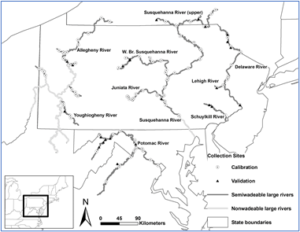A Multi-Metric Index for Large Mid-Atlantic Rivers
Interstate Commission on the Potomac River Basin
Assessing River Health
Current methods of assessing the biological health of large rivers are not as well developed as those for smaller, wadeable streams. In streams, biota found in the best environments—called “reference” conditions—are used as endpoints against which biota in other streams are evaluated (see Chesapeake Basin-wide Index of Biotic Integrity for Streams, also known as Chessie BIBI). Reference conditions in streams have good water chemistry, high-scoring habitat features, and relatively undisturbed watersheds. Reference conditions in rivers are difficult to find because the larger watersheds of most rivers inevitably have some level of human disturbance that affects the river.
A New Method

Study area with collection sites separated by calibration and validation datasets (from Shull et al. 2018).
ICPRB worked with Pennsylvania Department of Environmental Protection staff to develop a new method of assessing the health of large rivers. In 2016 and 2017, ICPRB collected water chemistry and physical habitat data and macroinvertebrate samples in the Potomac River mainstem and the lower Shenandoah. The resulting Potomac data were pooled with comparable data from the Susquehanna and Delaware rivers as well as major tributaries to the upper Ohio River. Abiotic characteristics of the river and watershed were used to create a stressor gradient and categorize sites as either least disturbed, intermediate, or stressed. Macroinvertebrate metrics that best discriminated between the site categories were selected for use in the large river multi-metric index called SWMMI, or Semi-Wadable Multi-Metric Index.
D. Shull, Z. M. Smith, and G. M. Selckmann. 2019. Development of a benthic macroinvertebrate multimetric index for large semiwadeable rivers in the Mid-Atlantic region of the USA. Environ. Monit. Assess. 191:22. https://doi.org/10.1007/s10661-018-7153-x
Return to Aquatic Life Main Page.
